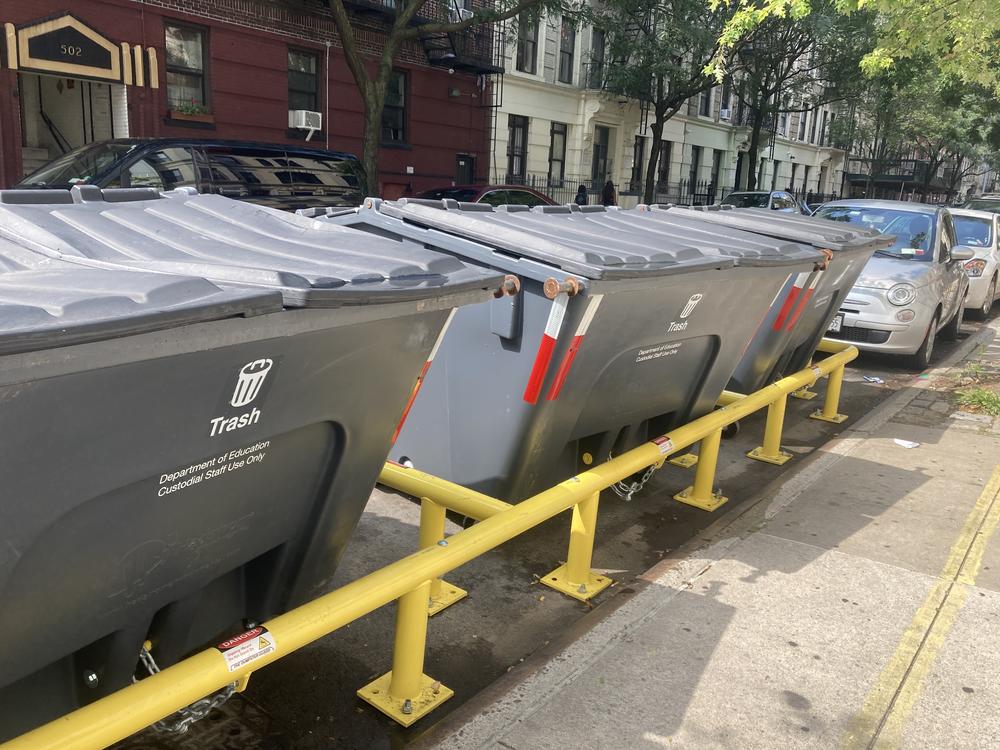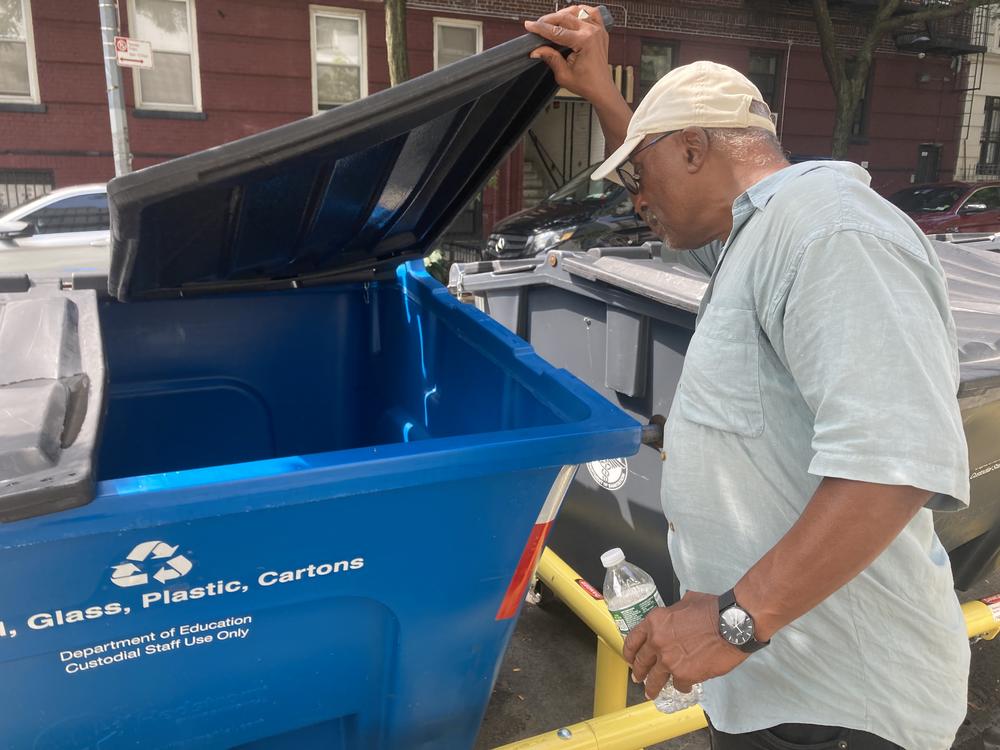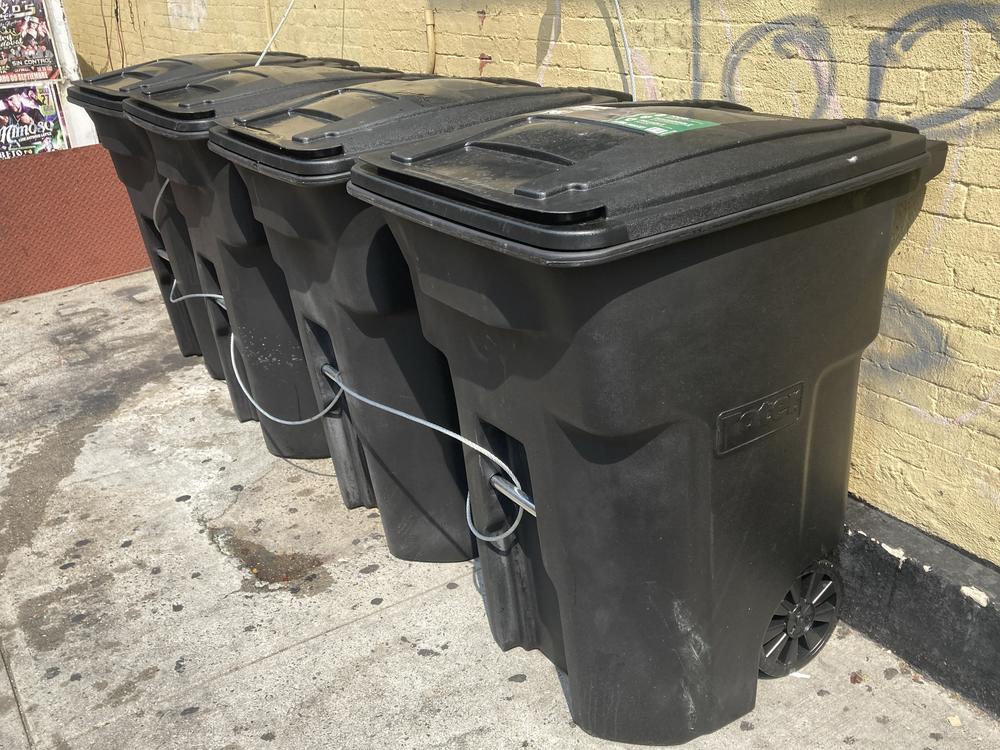Section Branding
Header Content
Curbside trash is a problem in NYC. Officials have a not-so-novel fix: plastic bins
Primary Content
On a recent fall morning in central Harlem, stacks of plastic garbage bags filled the sidewalks in front of the well-kept brownstones. Some of the black bags leaked brownish-gray liquid, others sat intermingled with discarded furniture. Several contained ragged holes in the sides, where they'd been chewed through by rats the night before.
This scene isn't limited to certain parts of New York City. It occurs throughout the neighborhoods in the five boroughs, from the residential streets of the Bronx to the skyscraper-filled blocks of Midtown Manhattan. Every evening, before nightly trash collections, New Yorkers fling bags out onto the sidewalks to be picked up by sanitation crews. Colonies of rats scamper back and forth, chewing through the thin plastic and nestling inside to feast on the contents.
After decades of this spectacle, New York City officials recently declared their intention to solve it in the same way most other U.S. cities have already: garbage bins. New York Mayor Eric Adams has announced containerization as the next phase of the city's "war on rats."
Each day, the majority of New Yorkers' 44 million pounds of trash ends up on city sidewalks for pickup. The city had used metal, Oscar-the-Grouch style trash cans decades ago, but after a citywide sanitation strike in 1968, they were replaced by bags alone. Over the years, the city has made multiple attempts to reduce the rat-and-bag symbiosis – from mint-scented bags to attempts to shorten their time outdoors – but the mess has been stubbornly difficult to clean up.
"New York is behind the curve" in containerizing its waste
Jessica Tisch, City of New York Department of Sanitation (DSNY) commissioner, told NPR the city is "behind the curve."
"Most cities around the country and around the world ... have transitioned to containerizing their waste," Tisch said. "And New York City has not."
In August, the department began requiring food-related businesses to place all waste in lidded, hard-sided containers, and regulations expanded to include large chain companies in September. The rules will extend to all businesses next March. By the fall of 2024, smaller residential buildings will join the list, and by mid 2026 their waste will have to go in "specific, official NYC bins." Eventually, Tisch said the mayor wants all of the city's waste in containers.
As more bins roll out citywide, their effects are starting to become visible on the ground.
Queens-based Mr. T Carting, one of the dozens of companies that manages New York's commercial waste, has outfitted its trucks with special levers to lift wheeled, 65-gallon bins into their back hoppers. Driver Christopher Albergo estimated that since more of the company's clients began using the bins, he's seen the number of rats decrease by around 60% or 70%.
"[There are] less rats, less roaches, maggots," he said. "[The bags] just go in the truck and we don't have to break our back as much picking them up."
In mid-September, however, not all businesses on Albergo's route had caught on. At most of the stops during the first two hours of his overnight shift, Albergo and his partner threw bags into the truck's hopper one by one, just as sanitation workers have done previously.
DSNY conducts inspections multiple times a day and occasionally shames businesses who don't follow the containerization rules on social media. A department spokesperson stated that officials issued a total of 22,313 warnings to food-related businesses and 5,561 warnings to chain businesses during the month-long grace period after each rule change. The department has now issued more than 2,651 violations to food establishments and 124 violations to chain businesses since the warning periods ended in September and October respectively.
Space and logistics may create challenges for NYC's trash containment strategies
As the city tests out future containerization strategies, the city's density may complicate matters.
A 96-page DSNY report released in April detailed the logistics of various containerization strategies. It concluded that containerization would be possible on 89% of residential streets, for a total of 77% of the city's total residential waste output. Doing so would include a combination of 39% large containers in the street and 50% individual bins. For the remaining 11% of the city – some of the densest areas – containerization wouldn't be possible because of the high volume of waste or obstructions on the streets or sidewalks.
The report also pointed to some of the costs, including retrofitting trucks to accommodate large shared containers, increasing collection frequency, and repurposing an average of "up to 10%" of the city's parking spaces for shared containers. It didn't calculate the total costs specifically, but noted a "substantial R&D investment" in fleet updates because no trucks in North America can currently accommodate the size of containers New York would need.
For some city residents, the parking and mobility tradeoffs are a particular concern. Victor Edwards leads a community board representing several neighborhoods in upper Manhattan, where a DSNY pilot program has begun placing dumpster-sized, lidded bins in streets. He noted that each set of bins takes up four parking spaces.
"We definitely want to get rid of rats – I'm not saying we want to live with rats," Edwards said. "But by the same token, I want to take into consideration [the] physically challenged people who have to carry these bags now ... our seniors, same thing – and parking," he said.
As officials plan for the future, experts say they should remain careful in how they gain compliance. While fines and other forms of punishment may work on businesses, Barbara Strach, co-author of The Politics of Trash, said cities that relied on punishment-based approaches for private citizens have received pushback in the past. When city officials used fines – and occasionally, jail time – on private citizens who didn't follow collection rules, residents revolted.
"In the case of New Orleans in the 19th century, this brought down the mayoral administration," Strach said.
New York City hasn't yet announced how it will enforce containerization rules for private citizens. Currently, officials are relying on incentives, like allowing residents to set out their trash two hours earlier each evening if it's placed in bins.
"No one likes to see the little 'Mickey Mouses' in their homes"
The Politics of Trash co-author Kathleen Sullivan said such incentives could be a good place to start, and continued that the most constructive approach would be to rely on social pressure, like how some cities in the early 20th century recruited civic organizations to model proper waste disposal.
"Rather than be seen as compliance with government power, it was seen as proper household behavior," she said.
Along with political will, proper expertise, the capacity to update infrastructure, and a source of public blame when things go wrong, officials will have a much easier time making the change, Strach added.
The containerization rules are a welcome change for many New Yorkers. Bronx resident Danielle Mills said she's looking forward to the bags off the sidewalks – especially because of the creatures that are sometimes inside.
"I walk in the street when I see trash [bags on the sidewalks], because I'm very scared of what's going to come out," she said. "So I like the way things are going."
Harlem resident Tameka Jordan said she's also looking forward to seeing fewer rats, and more containers will help.
"No one likes to see the little 'Mickey Mouses' in their homes," she said. I'm very afraid of them."
Mills, who owns a car, added that the parking sacrifices will be worth it since "lot of people put their trash in the street anyway."
And for Harlem resident Ocean Thomas, it goes beyond the rats. If other cities can containerize their waste, so can New York.
"When you visit other cities, the first thing you notice is ... 'wow, these cities are so clean– and it doesn't stink,' " she said. "Hopefully, now, the mayor will be on top of it."
Copyright 2023 NPR. To see more, visit https://www.npr.org.




